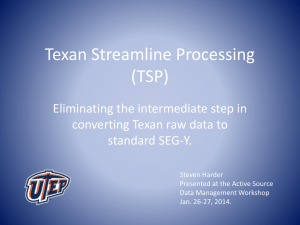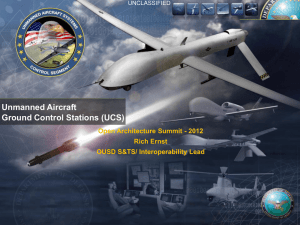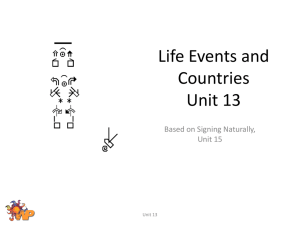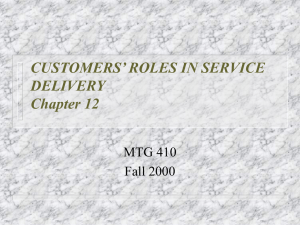08) Application (iPE..
advertisement
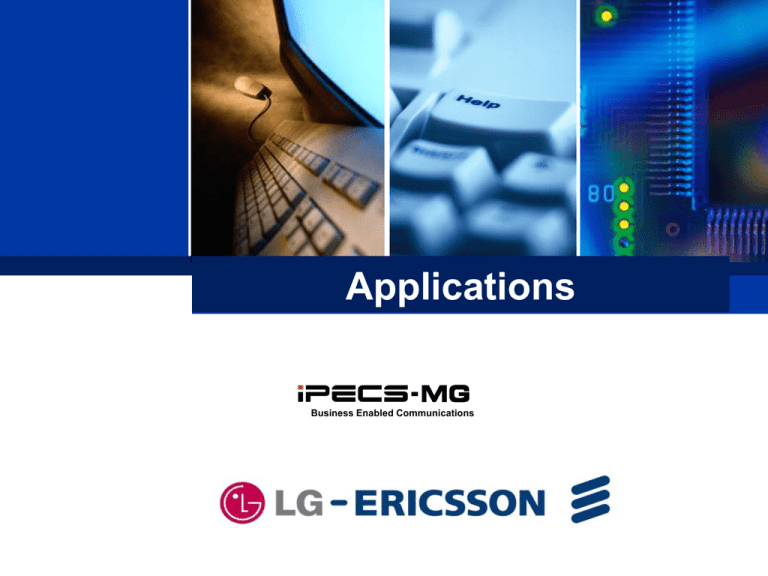
Applications Business Enabled Communications Contents Lock Key Phontage UCS NMS ez Attendant TSP ez Phone Lock Key ■ Condition - Install Lock key for iPECS-MG applications using Web Admin ※ Phontage : 2 copies free - System Management → Appliances Control → Lock Key Install Login ID/Password Registration ■ PGM 106(IP-Phone Registration) for Phontage, UCS Client - Administration → Pre-Programmed Data → IP-Phone Registration(106) : Assign ID and Password Phontage Introduction ▪ Definition • Softphone for PC or PDA (mobile device) • Abbreviation of “Phone advantage” ▪ Model name • Phontage Mobile (Phontage B) : Softphone for Mobile Device PPC 2003, Window Mobile 5.0 and 6.0, Symbian • Phontage Basic (or Phontage B) : Supports Basic features • Phontage Deluxe (or Phontage D) : Support Value added features Phontage Phontage iPECS-MG Phontage Login (4) (2) (1) (3) Phontage Phontage Deluxe Main UI Phontage UI & GUI UCS Overview UCS Components UCS Features; PBX(LIK,MG) UCS Server IP Phone (Call Feature), Presence, IM (Instant Messaging, Video Conference, Call Recording, Schedule, DB Import/Export, Application Sharing, UCS Client ※ Install Lock key for UCS clients using Web Admin Branch Configuration HQ UCS Server iPECS-MG UCS Client UCS Client Internet /Intranet UCS Client Phontage IP Phone WiFi Road Warrior UCS Login ▪ UCS Server Program Chatting ▪ UCS Client Program Directory ICR&Presence UCS Server Admin Diagnostic UCS ▪ UCS Server IP Address Assignment Web Admin UCS Login (2) (1) (3) (4) (5) UCS Features ■ UCS Features IP Phone (Call Feature) + Presence Instant Messaging + + Call Recording Schedule + Video Conference (6 Parties, 8 Groups) + DB Import/Export + Sharing / File Send + [Application Sharing] [White Board] UCS UCS Specifications > Server PC Specification - Intel Core 2 Duo 3G More, 2G RAM (600 clients at concurrent login) - Windows XP Pro., 2000/2003, Vista(Business, Enterprise, Ultimate) > Client PC Specification - Pantium Ⅳ, 2.3G, 512M RAM(Including Video Conf.) - Vista, XP, Windows 2000 > Interface Specification iPECS-MG Position Protocol iPECS Server ↔ MG LG-Ericsson Proprietary ICR,Presence Client ↔ MG LG-Ericsson Proprietary Call Server ↔ Client SIP Based LG-Ericsson Proprietary Directory,Chatting.. Client ↔ Client UCS Server Related Features TCP/IP(Session) LAN iPECS SIP Based TCP/IP (Session) Media(Data) UCS Client UCS Client NMS Overview • Network Management System for iPECS – – – – SNMP-based Information Management & Communication Web Browser-based User Interface using HTTP Up to 500 Systems can be Managed Integrated with iPECS-50/100/300/600/1200/MG ※ Install Lock key for NMS using Web Admin NMS • Classification Diagram Feature Classification – NMS Server Management / System Monitoring / System Management – Provides Web-based Interface for NMS Client NMS Server Management NMS Server Configuration NMS User Management Access & Operation History NMS DB & Service Control System Monitoring System & Device Configuration Device & Channel Status Alarm/Fault Management Network Traffic Monitoring Web-based iPECS-NMS System Management System & Group Management Call Statistics System DB / Firmware Upgrade Web Admin Integration NMS ■ Web Admin Administration → System Data → SNMP Data : - SNMP Agent : SNMP Service ‘ON’ - SNMP Trap : Enter NMS Server IP address Web Admin NMS Initial Login • • Open Login page using the IP address of NMS server Type Superuser ID and default Password. (admin / ipecsnms) NMS UI Component Description • Overall layout and the positions of main UI components are fixed, and they have their own functions and rolls. S/W Version of iPECS-NMS System Explorer Select or manage systems or groups of systems with a tree of nodes. Selected System User ID Loading Indicator A system selected using System Explorer The user ID that was used to login to iPECS-NMS Indicates that information is now being loaded Log-out Used to log out of iPECS-NMS Main Menu Used to enter each functional page such as ‘System Info’, ‘Status’, ‘Alarm/Fault’, ‘Call Stat’, ‘Network Traffic’, ‘Log’, ‘System’, ‘User’, ‘NMS’ Alarm/Fault Summary Functional Area Shows the number of alarms/faults that have not been checked by user Displays functional pages to implement the features provided by iPECS-NMS NMS Device Based Status • After entering ‘Device Based Status’ menu, select a system in System Explorer, and then device-based information will be displayed for the selected system. NMS CO Status CO Channel Status lists all the CO channels, and shows their channel status and channel/device information. Device Type The type of device for each CO channel can be designated by the color of the button frame. (VOIP, PRI, BRI, PSTN) NMS Station Status Station Channel Status lists all the Station channels, and shows their channel status and channel/device information. Device Type The type of device for each station channel can be designated by the color of the button frame. (IP-Phone, SoftPhone, SLT, DKT, DECT, DSS) NMS Alarm/Fault Management In order to load the Alarm/Fault log data only for a specific system, select a system in System Explorer, and then click [Load Log Data] button to retrieve log data for the selected system. [1] [2] NMS Alarm/Fault Event < Alarm Event (100 ~ 399) > Code Name Type Level 101 103 105 201 205 CPU Overload Link Up/Down Stand-by MFIM Status Device Up/Down Station Lock/Unlock Alarm Alarm Alarm Alarm Alarm MAJ CRI MAJ CRI MIN Locatio n MFIM I/F(#) MFIM DEV(#) STA(#) 211 SMDR Memory Capacity Alarm MAJ MFIM 213 301 VSF Memory Capacity System Connectivity Alarm Alarm MAJ CRI DEV(#) NMS < Fault Event (400 ~ 699) > Code 401 402 403 411 413 501 503 511 513 521 523 525 601 Name System Startup MFIM Switch Over Authentication Failure Station Capacity CO Line Capacity DSP Alert DSP Error DECT Base Status DECT GW Fault Device Line Up/Down Gatekeeper Connectivity SIP Proxy Server Connectivity Cabinet Fan/Power Failure Type Fault Fault Fault Fault Fault Fault Fault Fault Fault Fault Fault Fault Fault Level CRI MAJ MIN MIN MIN MAJ MAJ MAJ MAJ MAJ MAJ MAJ MAJ Location MFIM MFIM MFIM MFIM MFIM DEV(#) DEV(#) DEV(#) DEV(#) DEV(#) DEV(#) DEV(#) CABINET(#) < System Event (700 ~ 999) > Code Name Type Level Location 701 702 703 704 705 706 707 801 803 805 807 809 System Reset by Admin System ID Information Change System IP Information Change SNMP Reconfiguration Database Initialization File Upload Firmware Download Device Registration / Deletion Device Service Status Device Service Switch Status Device Firmware Download CO Line Outgoing Block Status System System System System System System System System System System System System CRI MAJ MAJ MIN MAJ MIN MAJ MAJ MIN MAJ MAJ MIN MFIM MFIM MFIM MFIM MFIM MFIM MFIM DEV(#) DEV(#) DEV(#) DEV(#) (#) 811 812 CO Gateway Order Change Station Number Change System System MAJ MAJ DEV(#) STA(#) 813 Soft Phone Log In/Out System MIN DEV(#) 815 Hot Desk Log In/Out System MIN DEV(#) 819 Long Time Call System MAJ (#) ez Attendant Overview ez Attendant software can manage the various type of call with your PC. When the attendant works with another type of working (for example, word processing), the attendant can minimize this software with button. If an incoming call is occurred during the word processing, the pop up windows will be activated with simple information about the caller. At that time, attendant should do its own operation. And the call related operation is depending on the Call server system feature. For example, the capacity of queue size or recall timer are depend on the Call server system itself. But PC related features are independent with Call Server system. Condition : Install Lock key for ez Attendant using Web Admin ez Attendant Execution of ez Attendant Execution of ez Attendant 1. Select System(iPECS-MG) 2. Input System IP Address 3. Input Attendant Extension Number 4. Click [Log On] button 5. Log On is processing ez Attendant Main Window Main Menu Tool Up Bar Active Call Window Station Window Phone Book Log –View Optional(Icon/List) Queue Window Search and Info MS scheduler Pre_selection SMS 601 Park Location Tool Down Bar ez Attendant Main Menu Menu Description ez Attendant Menu Description Tool Up Bar Log On Log Off Print for Log View Open Outlook ez Attendant Menu Description Station Window & Queue Window Active Call Window Station Window Queue Window • Active Call & Queue Window Icon • Station Window Main Icon ICM Incoming DKTU(Busy) DND State CO Incoming DKTU(Idle) Forward State Hold state Call SLT(Busy) Net DSS (Idle) Park Recall SLT(Idle) Net DSS(Busy) Hold Recall WHTU(Busy) Net DSS(DND) Attendant Recall WHTU(Idle) Transfer Recall • Station Window Sub Icon Pre-selected Message • CO Line Status Icon Idle CO Line Busy CO Line Transfer Hold CO Line Invalid CO Line ez Attendant Phone Book Window Menu Description ez Attendant Menu Description Log-View Window Selection Field Search Field TSP(TAPI Service Provider) Introduction Windows OS • Microsoft Windows based telephony driver - TAPI application Use TAPI function (Ex. lineMakeCall) TAPI application Made by 3rd party vendors ex) Outlook dial, ez Phone, Call Center - TAPI (Telephony API) TAPI v2.1 Made by Microsoft Contain TAPI function(call, phone) - TSP (TAPI Service Provider) TSP v2.1 LGE TSP Made by Telephony system vendors Dynamic Link Library(DLL) ex) LG-Ericsson TSP, • Compatible with TAPI 2.1 - LG-Ericsson TSP supports TAPI 2.1. LAN TSP(TAPI Service Provider) Introduction • LG-Ericsson Systems - iPECS-LIK 100/300/600 - ipLDK-100/300/600 - ipLDK-20/60/Nexer/Soho - iPECS-MG 100/300 • Terms - 1st Party Connection: The application can see only one line assigned in Web Admin (Station Port Data CTI IP Address) and control one line. - 3rd Party Connection: The application can see all lines and control all lines. • Lock Key - 1st Party Connection : ez Phone Lock key is needed. - 3rd Party Connection : 3rd Party TAPI Lock key is needed. TSP(TAPI Service Provider) • Configuration (1st party connection) iPECS-MG/ipLDK-20/60/Nexer/Soho - PC is connected to the system via LAN. - PC User can use the keyset assigned by Web Admin (Station Port Data CTI IP Address) - DKT, SLT and DECT are available. LGE TSP installed(1st) PC: Windows Keyset: DKT/SLT/DECT LGE TSP installed(1st) PC: Windows Keyset: DKT/SLT/DECT LAN TSP(TAPI Service Provider) • In Web Admin (Station Port Data CTI IP Address), type a client IP address in Edit box, click [Update] button. Web Admin TSP(TAPI Service Provider) • 3rd - Configuration (3rd Party Connection) Party Connection (Using Remote Service Provider of Microsoft) Server is connected to the LGE system. Server user can use all keysets connected to the system. Client user can use his keyset assigned by Server PC. LGE TSP installed(3rd) Control Path Server: Windows 2000/2003 Server Client: Windows OS Windows Domain LAN Keyset: DKT, SLT, DECT Client: Windows OS Keyset: DKT, SLT, DECT TSP(TAPI Service Provider) • Select System - ipLDK-100/300/600 - ipLDK-20/60/Soho - iPECS LIK, MG • Select Service Mode - 3rd Party Connection (LAN Connection Only) - 1st Party Connection (LAN Connection Only) • Select Connection Method - COM1/COM2 ipLDK-100/300/600 only - LAN, System IP Address Installation TSP(TAPI Service Provider) • Installation - You should install LG-E TSP on each computer - Reboot computer • TSP Settings - Open [Phone and Modem Options] in Control Panel. - If [Location Information] dialog is appeared, then select country/region, and insert area code and outside dial number. These codes are used for CO calls. - On the [Advanced] tab under Providers, click [Telephony Service Provider for LG-Ericsson System] - Verify if the System IP Address is correct or not. - Verify if the Service Mode is correct (1st Party or 3rd Party Connection.) TSP Settings ez Phone Overview Provides easy & powerful control of voice communications on your PC Easy installed, maintained, user graphical, user interface 2 packages (Entry, Deluxe) Powerful feature like SMS to extension even DECT terminals Compatible with MS Outlook, ACT, GoldMine and more Standard interface : TAPI ez Phone Overview There are two types of ez Phone version. One is an entry, the other is a deluxe. Please refer to the below table for each version’s function. Entry Concept Functionality Local DB, Capacity Limit Basic DKTU feature New Database Creation - Access - Excel Call Control - Make Call - Hold Call - Park/Unpark - Transfer Import DB (Access, Excel) Export DB (Access, Excel) Print Address book Forward(Internal, Off-net, VMIB) Always on top All features for Outlook are not available. Deluxe DB Conversion SMS to Keyset Attendant Integration All Features of Entry Version Import DB (outlook) Export DB (outlook) VMIB control - MsgWait - OutMessage - Paging Message Flex button assignment ACNR E-MAIL All features for Outlook are available. (Outlook Contact) Differential ring by CLI Scheduled Dial KeySet SMS Call Filtering - VIP/Black List by DND/FWD/Ring ez Phone Configuration(1st Party Connection) *NOTE : ez Phone does not support 3rd party connection. LGE TSP installed(1st Party) ez Phone PC: Windows Keyset: DKT/SLT/DECT LGE TSP installed(1st Party) ez Phone PC: Windows Keyset: DKT/SLT/DECT LAN ez Phone Main Window Main Menu Top Tool Bar Call Window Information Window Message Window MS Scheduler Station Information Window (Double Click & Call) Display Station Type Optional(Icon/List/Report/Small Icon) Icon Menu(bottom) ez Phone Main Window ez Phone Top Toolbar Open Outlook Log On/Off ez Phone Station Information Windows Filtering Field Option Status ez Phone Display Station Type 1. Display Station Type(REPORT) 2. Display Station Type(ICON) (Double Click & Call) 3. Display Station Type(SMALLICON) Display Station Can display station more 4. Display Station Type(LIST) ez Phone Call Window Connected Call Holding Call Make Call, Transfer or Search


